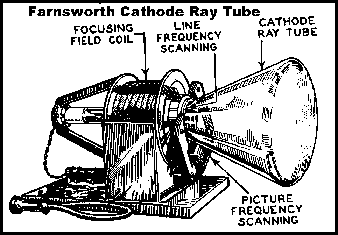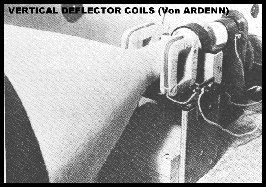|
Television Experimenters.com
Cathode Ray Tubes
Cathode Ray Tubes (CRTs)
|
If you think about it, you might come to realize that there is a lot of similarity between the operation of cathode ray tubes and the mechanical scanning systems already described. For instance, a CRT has vertical and horizontal
sweep signals that develop the raster. The scanning disk also provides these sweeps. Because it is rotating, each scanning hole performs a sweep and with each hole being displaced one hole width from the others, they together provide a second sweep, perpendicular to the first. The same is true of all of the other scanners. In a CRT, the electron gun has a means of controlling the
density of electrons and therefore the brightness of the scanning spot on the screen. In a similar way, mechanical systems have the means to control spot brightness too. And like the CRT, the control of brightness is done before
the scanning takes place. |
|
 |
The only problem with this comparison is that long before the CRTs could produce television images, the mechanical systems were out there doing it. And for a long time, they did it better!
For Example: Except for the vibrating mirror systems, all of the rotating disc mechanical scanning techniques, produce linear sweeps or scans. In the 1920s when Farnsworth, Zworykin and the others that were working with CRTs, they were using sine wave sweeps, usually supplied by small motor generators. This caused shading problems in the image and synchronizing problems between the sweeps. At some point, someone ( maybe Farnsworth first ) must have looked at an operating mechanical system and realized that the sweeps were in fact linear and they needed to do the same with CRTs. This suggests that the mechanical systems may have often been a model for the electronic versions.
The cathode ray tube of today has many important advantages over the mechanical scanners. The first of which is that it can operate at extreme speeds. Another is that it is has a low cost for what it does. It has good image qualities, such as brightness, contrast, and resolution as well as long life. Another important reason for the experimenter to consider using the CRT is that unlike mechanical scanners, which are generally limited to the format they were
designed for, CRTs can be easily changed from one format to another, usually by the twist of a knob.
Because of the popularity of television over recent years, many varieties of CRTs and their accessories are available on the new and used market at reasonable prices. This is an ideal situation for the television experimenter. Many times, they even throw away sets that often contain many useful components.
PY
|
 |

All rights reserved.
|